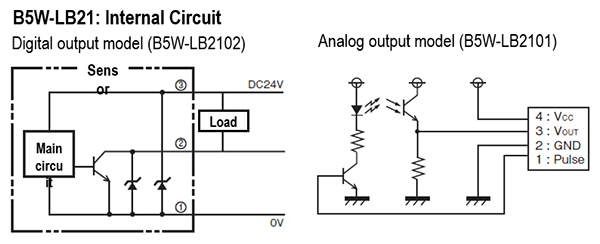How to use differently between the digital output model and analog output model of light convergent reflective type optical sensor B5W-LB21?
ID: FAQE40036E
update:
Answer
Select the analog output model of Optical Sensor: B5W-LB in cases where the digital output type cannot stably detect objects or when external disturbing lights affect detection.
Explanation

The B5W-LB series sensors consist of an optical lens (with visible light cutting filter), an infrared LED, a light receiver, and an analog circuit. Both the digital output model and the analog output model have the same optical characteristics and only differ with internal circuit.
The digital output model includes an LED pulse-driven circuit and its threshold level is fixed. Regarding the analog output model, the LED device should be driven with a pulse signal from an external circuit. The threshold level for output voltage should be properly set from an external circuit. An external disturbing light canceling method can be used with the analog output model.

With its simplicity of use, the digital output model will be recommended for a normal object detection. However, the analog output model, which can set up an optimum threshold level, is suitable for variety of applications, such as:
- When the sensing object is small (amount of reflected light from an object is low)
- When a background object is near the sensing area (reflected lights from unexpected object)
- When external lights disturb the sensor
Quick tips
For an analog output model, the optimum threshold level setting method is as follows: A photosensor detects an object by the ratio of the amount of received light with and without the object. If the amount of received light when an object exists is Signal (S) and when an object does not exist is Noise (N), a larger signal/noise ratio will make sensing more stable. For example, if the sensing object can be set at the peak of “Receiver Output vs. Sensing Distance” curve, this can make S larger. On the other hand, if the background can be set far away from the sensor or equipment design can reduce disturbing external light, N can be reduced. In order to achieve longer and more stable sensing in your equipment, the worst case values of S and N should be simulated and a threshold level set at the midpoint between S and N. For example, Signal will be changed by LED degradation, temperature, distribution of sensing objects, position fluctuation (distance, angle) of sensing object, etc. Evaluating with actual equipment will be essential to simulate the worst case of Signal and Noise.
| Product category | Sensors Light Convergent Reflective Sensors/Diffuse Reflective Sensors |
|---|---|
| Classification | Selection, Characteristics |
| Related keywords |
|